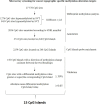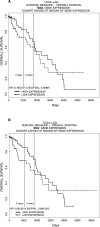Integrated DNA methylation analysis identifies topographical and tumoral biomarkers in pilocytic astrocytomas
- PMID: 29568396
- PMCID: PMC5862617
- DOI: 10.18632/oncotarget.24480
Integrated DNA methylation analysis identifies topographical and tumoral biomarkers in pilocytic astrocytomas
Abstract
Pilocytic astrocytoma (PA) is the most common glioma in pediatric patients and occurs in different locations. Chromosomal alterations are mostly located at chromosome 7q34 comprising the BRAF oncogene with consequent activation of the mitogen-activated protein kinase pathway. Although genetic and epigenetic alterations characterizing PA from different localizations have been reported, the role of epigenetic alterations in PA development is still not clear. The aim of this study was to investigate whether distinctive methylation patterns may define biologically relevant groups of PAs. Integrated DNA methylation analysis was performed on 20 PAs and 4 normal brain samples by Illumina Infinium HumanMethylation27 BeadChips. We identified distinct methylation profiles characterizing PAs from different locations (infratentorial vs supratentorial) and tumors with onset before and after 3 years of age. These results suggest that PA may be related to the specific brain site where the tumor arises from region-specific cells of origin. We identified and validated in silico the methylation alterations of some CpG islands. Furthermore, we evaluated the expression levels of selected differentially methylated genes and identified two biomarkers, one, IRX2, related to the tumor localization and the other, TOX2, as tumoral biomarker.
Keywords: gene expression alteration; human methylation beadchips; methylome alteration; pilocytic astrocytomas; topographic and tumor biomarkers.
Conflict of interest statement
CONFLICTS OF INTEREST None of the authors has conflicts of interest
Figures







References
-
- Burkhard C, Di Patre PL, Schüler D, Schüler G, Yaşargil MG, Yonekawa Y, Lütolf UM, Kleihues P, Ohgaki H. A population-based study of the incidence and survival rates in patients with pilocytic astrocytoma. J Neurosurg. 2003;98:1170–4. https://doi.org/10.3171/jns.2003.98.6.1170. - DOI - PubMed
-
- Jones DT, Hutter B, Jäger N, Korshunov A, Kool M, Warnatz HJ, Zichner T, Lambert SR, Ryzhova M, Quang DA, Fontebasso AM, Stütz AM, Hutter S, et al. Recurrent somatic alterations of FGFR1 and NTRK2 in pilocytic astrocytoma. Nat Genet. 2013;45:927–32. https://doi.org/10.1038/ng.2682. - DOI - PMC - PubMed
-
- Zhang J, Wu G, Miller CP, Tatevossian RG, Dalton JD, Tang B, Orisme W, Punchihewa C, Parker M, Qaddoumi I, Boop FA, Lu C, Kandoth C, et al. Whole-genome sequencing identifies genetic alterations in pediatric low-grade gliomas. Nat Genet. 2013;45:602–12. https://doi.org/10.1038/ng.2611.Whole-genome. - DOI - PMC - PubMed
-
- Gnekow AK, Falkenstein F, von Hornstein S, Zwiener I, Berkefeld S, Bison B, Warmuth-Metz M, Driever PH, Soerensen N, Kortmann RD, Pietsch T, Faldum A. Long-term follow-up of the multicenter, multidisciplinary treatment study HIT-LGG-1996 for low-grade glioma in children and adolescents of the German Speaking Society of Pediatric Oncology and Hematology. Neuro Oncol. 2012;14:1265–84. https://doi.org/10.1093/neuonc/nos202. - DOI - PMC - PubMed
-
- Lambert SR, Witt H, Hovestadt V, Zucknick M, Kool M, Pearson DM, Korshunov A, Ryzhova M, Ichimura K, Jabado N, Fontebasso AM, Lichter P, Pfister SM, et al. Differential expression and methylation of brain developmental genes define location-specific subsets of pilocytic astrocytoma. Acta Neuropathol. 2013;126:291–301. https://doi.org/10.1007/s00401-013-1124. - DOI - PubMed
LinkOut - more resources
Full Text Sources
Other Literature Sources
Research Materials

